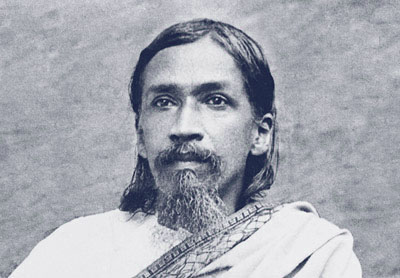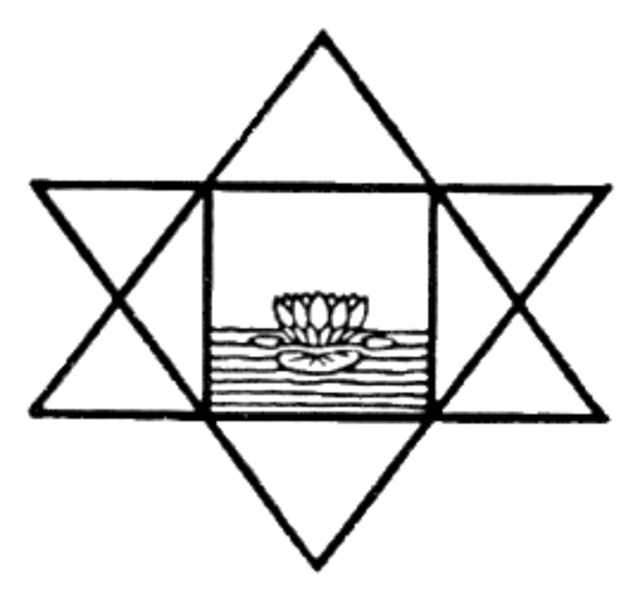
Sri Aurobindo is another of India’s great saints. His person and his work of Integral Yoga are of impressive greatness and charisma. He lived from 1872 to 1950.
His innovations on the yoga path are evolutionary. Here is a quote from the book “Light on Yoga”, first chapter, The Goal:
“The path followed by this yoga differs from other yoga paths in its purpose, for its aim is not only to lead man up from the ordinary, ignorant world-consciousness to divine consciousness, but also to bring down the supramental power of this divine consciousness into the ignorance of the mind, life and body, to transform them, to reveal the divine in the world and to create a divine life in matter.“
and further on he writes:
“This is an extremely difficult goal to achieve and a difficult yoga. To many or most it will seem impracticable. All the forces rooted in the ordinary ignorant world-consciousness resist it, oppose it and try to obstruct it, and the sadaka will meet the strongest resistance to its realization in his own mind, life and body.”
For the Indian world view, the earthly world is nothing other than Maya, the illusion of matter that will pass away. The goal of every ascetic, every sadhu, is to get rid of the world, to overcome it in order to finally enter completely into the divine. In classical yoga , for example, the practitioner tries to work his way up step by step with the help of raja yoga until he finally reaches samadhi, the divine consciousness. His goal is then achieved.
Aurobindo’s Integral Yoga reverses a millennia-old tradition, which is very remarkable. The old “flight from the world” is reversed: now the direction of movement goes from the spiritual into the earthly, material life! A new form of spirituality is born.
One should not imagine that everything that had gone before was no longer valid. Sri Aurobindo held the traditional yoga traditions in high esteem, studied them in depth and integrated them into his work. Nevertheless, he transformed them and elevated them to a completely new, forward-looking level.

Sri Aurobindo’s symbol:
The descending triangle stands for Sat-Chit-Ananda. The ascending triangle represents the ascending response of matter in the form of life, light and love. The union of the two – the central square – is the perfect manifestation with the Avatar of the Supreme – the Lotus – at its center. The water – within the square – represents diversity, creation. (commons.wikimedia.org)
Who was this person? And why was he accepted and heard in both the East and the West during his lifetime?
Since much has already been written about his life and work, I refer to existing pages, for example from the Sri Aurobindo Ashram Trust in Pondicherry or Anthrowiki.
Aurobindo received a Western Christian education in India. He received his school education in England and studied several languages such as Greek and Latin. He spoke fluent French and even learned German in order to study the classical works of the great German poets and thinkers in the original language. Throughout his life, he wrote his books in English. It was only when he went back to India – completely anglified – that he really got to know and appreciate his homeland, Indian culture and Indian languages.
He was therefore deeply familiar with European-Western and Indian-Eastern ways of life and cultures. Presumably, this enabled him to find the right language in his writings and to make his descriptions understandable worldwide in both East and West.
The books in his oeuvre certainly comprise over 300, 400 and 900 pages and more. Fortunately, 3 small paperbacks are a good way to get a first impression of his person, his life and his work:
Sri Aurobindo by Otto Wolf on the course of his life
The integral yoga of Sri Aurobindo
Light on Yoga by Sri Aurobindo
Auro Media offers a wide range of literature.
Hatha Yoga is not explicitly part of Sri Aurobindo’s Integral Yoga. Nevertheless, the principle of Integral Yoga “from top to bottom” will be expressed in a very artistic way in the physical exercises at a later time.
(Note for differentiation: there are other yoga approaches that call themselves Integral Yoga)
While most yoga styles have precise details of exercise forms, methods, meditations, rituals and instructions for studies etc., this is not evident in Integral Yoga. The philosophy is essentially what meets the interested party.
For Aurobindo, however, philosophy(philosophia, literally “love of wisdom”) goes beyond intellectual-logical imagination and reflection, the so-called “philosophizing about metaphysical connections”. He understands philosophy as a description of metaphysical facts that he has seen on the basis of spiritual experiences. He sees the essential goal of philosophy in this direct, real spiritual vision.
We will examine the significance of this life’s work in more detail later in connection with Rudolf Steiner and Heinz Grill.
Continue to page: Yoga development in Europe
Bildquellen
- sa04: Sri Aurobindo Trust, India | Public Domain Mark 1.0
- Sri-Aurobindos-Symbol: https://commons.wikimedia.org | Public Domain Mark 1.0
